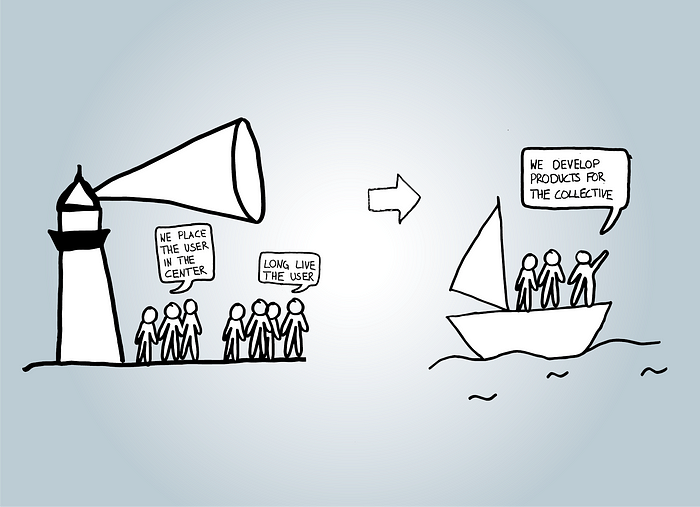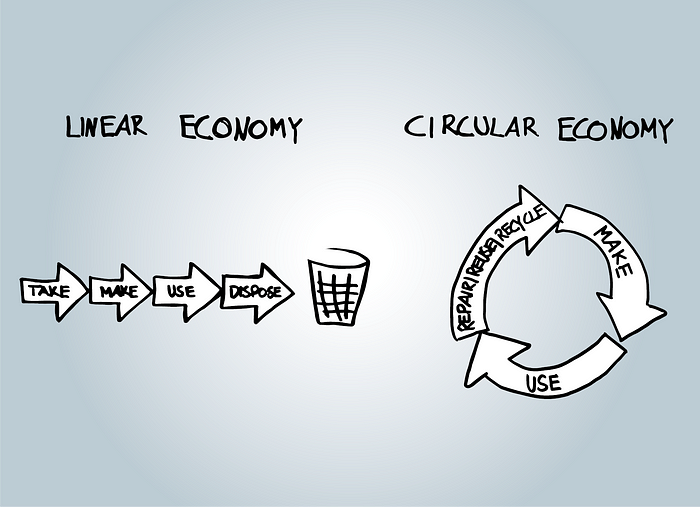It’s time we move to life-centered product development
User-centered product development has been the mantra of the tech industry for decades. While I’d argue most companies still fail to fully implement this approach, others have been wildly successful with it. Think Amazon, Apple, or Airbnb (and that’s just the As).
However, their success shows us the downsides of solely focusing on the user. If the user is the measure of all things, others who will be impacted by a product — like society or the planet — may be forgotten.
That’s why I believe user-centered product development is no longer fit for purpose. It’s time we developed the concept further and practiced life-centered product development.
Life-centered product development factors in the whole system around a product. As a response to changing societal values and the environmental crisis, it considers a broader scope of users, stakeholders, and all product life stages.

The design community has played with the concept for a couple of years. But in today’s world products are developed by interdisciplinary teams. The underlying technology and business models are as critical for a product’s success as its design. Engineers, designers, product managers, anyone part of an empowered product dev team… We’re all responsible for the world we shape with the products we make.
Let’s bring everyone to the table and talk life-centered product development. Why is it important? And how do we implement it? Read on…
Note: I’m going to use UPD (user-centered product development) and LPD (life-centered product development) going forward otherwise we’ll all be here a while.
A brief history of user-centered product development
“We’re all about the user.” “Our highest priority is to satisfy the customer.”
How often have you heard those statements? Working in the tech world we know these principles all too well. We have an almost manic user-centric focus.
Here’s how UPD has developed over the years:
- In the 1960s, the idea of empathy as a means to designing truly valuable solutions was born when participatory design gained momentum in Scandinavia.
- The design agency IDEO took the concept further. They coined the term human-centered design to describe a creative problem-solving process that begins with understanding human needs and ends with innovative solutions to address said needs.
- The rise of Agile then saw customer collaboration became a cornerstone of modern software development.
- And in recent years, with the increasing popularity of SaaS products which see customers easily churn when not happy, user-centricity got yet another boost.
Today, it’s common practice for product dev teams to observe, interview, co-create, and test prototypes and product features with users along the entire product dev cycle. Even the underlying business models are now designed while keeping the user needs in mind.
In user-centered organizations, product managers, who originally were supposed to present the business side in product development, are now primarily focused on the user. User-centricity is considered THE means to achieve business success.
The downside of all this user focus? We’re missing the big picture.
The pitfalls of user-centered product development
A single user or user group is just one element in a bigger ecosystem. By putting them in the center of everything, rather than addressing them as part of an ecosystem, we might easily improve things for the user at the cost of making things worse for other stakeholders.
Let’s take Zalando (the German Zappos). From a user’s perspective, it’s an outstanding product. They’ve considered every step of the digital shopping experience, but that experience doesn’t end in the digital world. Orders are delivered quickly and, if they don’t fit, you can easily send them back at no cost. Zalando translated a major advantage of offline shopping to the digital world.
But providing this comfort to the user comes at a cost to the environment. t3n reports that around 50% of Zalando's orders are sent back. This is crazy. Think about the ecological footprint this leaves.
Zalando isn’t the only one. Just look at Airbnb where the whole experience for both travelers and hosts has been thought through to the last detail. As a traveler, you receive all the details about your rented apartment upfront. Even if something goes wrong you’ll be supported by an outstanding customer support team. As a host, you get access to a range of services too, like liability insurances and professional photographers.
This ease comes at a cost though. Airbnb-rented properties are accused of taking housing stock away from residential use, contributing to increased rental prices. The company itself has been widely criticized for benefiting the few while damaging the many.
Why change now?
The problem with UPD today is that companies like Zalando or Airbnb are not being held accountable for the externalities of their products, or the societal changes their products induce. They are measured by their financial returns, not by their impact on the environment and society.
Some might say it’s the responsibility of governments to put the right regulations in place. But, while governments certainly have a part to play, innovators and makers are producing products that are shaping the world faster than politics can keep up. It’s time for the tech industry to step up.
While our industry is thriving, we are facing an environmental crisis and are still far from reaching social equality. If not the prosperous tech industry who else could take a leap of faith and work in forward-thinking ways that consider the user as well as the rest of the world?
Another argument is that users and their needs are changing. A growing number of people are becoming more conscious consumers (see Fjord’s Trend Report). Yes, people still consume products. However, they increasingly do so to support a cause and/or favor those advocating minimal harm to the planet and society.
The very users you used to put in the center are starting to demand you consider others too. They are willing to trade certain comfort for the greater good of society and the environment. I believe this trend will become mainstream and that recognizing the bigger picture means ensuring future business success.
Fortunately, there are companies already leading the way on this.
Take Lemonade — the tech-enabled digital insurance company. They pay insurance claims, earn a flat fee, and give whatever is left over to a charity. Thus, there is no conflict of interest between Lemonade and their customers (which is a great innovation in the insurance market) and communities benefit from donations. Lemonade neatly knits together user needs and social good. Yet (or maybe due to this approach), they are a unicorn.
I refer to this new way of thinking and developing products as LPD.
What is life-centered product development?
There isn’t one set definition of LPD yet but, from my own reading and experience, here’s how I describe it:
Life-centered product development is an evolution from user-centered (or human-centered) product development. It’s about shifting from developing products for one, to developing products for the collective.
This type of product development requires a systems-mindset that — as Jane Fulton Suri puts it — embraces the complexity of an ecosystem where things co-exist and interrelate. It balances purpose and profit by considering the impact of a product on the following four areas:
- The customers and users
- The people who build and supply it
- Society
- The environment
My interpretation of LPD is similar to the idea behind B Corps. As Fjord describes it, LPD means “practicing do no harm in all areas”.
How can we apply life-centered product development?
To apply LPD effectively, we need to evolve how we look at the following three areas:
- Stakeholders: Move from empathizing with just our users to empathizing with the entire ecosystem that will be affected by our product.
- User groups: Move from developing for a specific user group to developing for multiple user groups (including those unwanted groups that may misuse our product).
- Product life stages: Move from considering only the usage stage of a product, to considering its production, distribution, and afterlife stages.
LPD is still in its infancy, but below are some ideas on how to make these shifts in your day-to-day product development activities. It’s by no means a comprehensive list but acts as a starting point for further discussions and contributions (please do add yours in the comments below).
How to consider all stakeholders
UPD teams consider and involve the user in all stages of product development. LPD teams consider all human and non-human stakeholders that will be affected by a product along its development cycle — from doing user research to measuring the impact and perception of a product and how to optimize it.

Here are two ideas on how to do this effectively:
1. Build a stakeholder map
This should consider all direct and indirect, human and non-human stakeholders of your product or product feature. You can use Monica Sznel’s helpful canvas as a guide.
Compared to the standard stakeholder map, Sznel’s map includes non-human stakeholders. These can be everything from the water required to produce certain parts of your product, to the air that might be polluted by the shared cars your digital service is renting out.
Once all stakeholders have been listed, consider how they interrelate and map out their cause-effect relationships. You should refer back to those stakeholders and their interrelations whenever you do research, make a product decision, or measure how your product is being used and perceived.
2. Rephrase considerations
When evaluating new solutions (be it a new product or simply a new feature) based on the well-known desirable-viable-feasible-framework, rephrase the respective considerations:
- Desirable: Which user needs can we fulfill with this solution? And where should we make a trade-off in terms of convenience, ease of use, or efficiency which doesn’t undermine a contradicting need of a stakeholder?
- Feasible: How can we build this solution with minimum harm to the environment and without exploiting any service providers or suppliers in the process?
- Viable: How can we turn this into a solution that is profitable for our business even when we consider all external costs?
How to consider all user groups
No product development starts with a bad intention. At the start of any UPD process is a problem you want to solve or a benefit you want to provide to the user. However, many products turn into something their creators didn’t intend and would have liked to avoid.
Social media platforms serve as a good example. The majority were not designed to distribute hate speech. Nor was YouTube designed to radicalize people based on conspiracy theories. How did we get here?
I would argue it’s a result of UPD’s narrow user focus. It tends to look at one specific user group: those that currently have a problem that the product should solve. It doesn’t ask the question of what will happen if another unintended user group uses the product.
In a world where we are increasingly designing for the emergence of behaviors, where we are building platforms and systems that will evolve, it’s time to consider different user groups — including the unwanted — right from the start.
I propose that LPD teams should always pose two critical questions during their discovery work:
- Who could potentially misuse this product or feature? How can we avoid this?
- What would we need to consider if we imagined that our user group would expand and our product would be used by almost every human being around the world?
How to consider all product life stages
As UPD places the user above all else, it naturally focuses on the usage stage of a product. LPD goes further to consider its production, distribution, and afterlife.
You might think that for pure software products these stages don’t play a role, but consider the energy that is required to power the servers which host your software and data.
In a certain way, data centers are for the software industry what production facilities and junkyards are for the hardware industry. Hence, as product dev teams, let’s choose data centers that have signed the Climate Neutral Data Centre Pact and agreed to become climate neutral by 2030. And let’s ask ourselves how to design software in an energy-efficient way.
For connected devices, the relevance of the production and afterlife stages is even more obvious. E-waste is now the fastest growing waste stream in the world (according to the World Economic Forum and PACE Initiative), with only 20% of it managed appropriately from an ecological perspective.
As the people behind these products, I believe we have a crucial role to play in reducing the resulting waste by extending the physical life of a connected device and its ability to be repaired, recycled, or reused.
How do we do this?
We look at the circular economy approach which explores different methods for how to develop products that can be ‘made to be made again’.

The circular design guide developed by IDEO and the Ellen MacArthur Foundation is the best source I’ve come across for concrete ideas on applying the circular economy. It contains a number of super useful tools and approaches so do check it out.
So what now?
LPD isn’t an easy practice (as the above probably shows!).
For us product development teams it puts more restrictions on the work we do. It requires us to dig into complex systems, gauge correlations between various stakeholders, and apply new methods and tools. For our businesses, it might put the quick money at risk and require us to take a leap of faith that it will pay off in the long run.
No one said being a pioneer was easy!
We are very fortunate in the tech industry though. We have the ability to quickly change how we do things and, in this case, we must. There’s little point building products for a world that doesn’t exist anymore.
I’m convinced that LPD will attract and retain the best talent, customers, and partners while safeguarding the environment and a functioning society.
Either way, LPD is a mindset and methodology that will only succeed if it’s imprinted in the DNA of a company and lived and breathed by everyone who is part of a product’s development.
Dear product development teams, are you up for the challenge?
